Home | About | In | Out | Us | Them | Table of Contents
Turkey
Do not be intimidated by the turkey. Anyone can make a great turkey dinner by following a six simple steps.
Prologue: The Right Bird
If it can possibly be avoided, don't buy an industrial turkey that's been raised in a cage on a factory farm, shot up with antibiotics, and had its carcass pumped full of broth as a "flavor enhancer" before ending up in a shrink-wrapped plastic sack in your florescent-lit supermarket. Let's not even think about frozen turkeys unless we are celebrating in some remote wilderness location without access to fresh foods. We should all be thankful for the hardworking farmers preserving America's countryside, so seek out your local heritage, free range, or otherwise humanely raised birds. It's not just ethical eating, because you'll find that happy turkeys are also more flavorful turkeys.
If you happen to live in the Philadelphia area, Amish farmers are your best bet for locally raised turkeys at very reasonable prices. The poultry vendors at Reading Terminal and other local markets begin taking orders in early November and usually continue until the week of Thanksgiving, but call early to make sure you can reserve a bird that's exactly the size you need. You'll be assured a bird that was clucking around just a day or two before you take it home -- just watch out for stray pin feathers!
As far as size matters, it seems one pound per person is ideal, but we always add in a couple extra for leftovers.
Step One: Oh, Whoa, Whoa, Sweet Turkey-Child of Brine
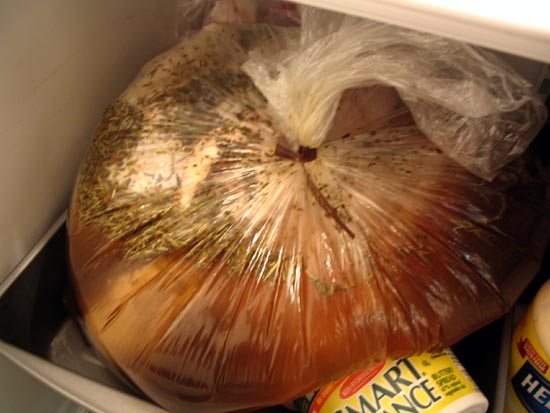
In the great brining debate, we side with the brine believers. Maybe it doesn't do anything at all, but it surely doesn't hurt. To make brine, dissolve one cup of salt into each gallon of water needed to cover your bird breast-side down inside a tub, a plastic bag, or any other food-safe container that fits your turkey and your fridge. One might add sugar, spices, and other seasonings, but the salt is all that really matters. If you heat the water to dissolve the salt, keep in mind that the brine must be chilled completely before plunking in the turkey. Refrigerate the turkey in brine for at least eight hours before cooking.
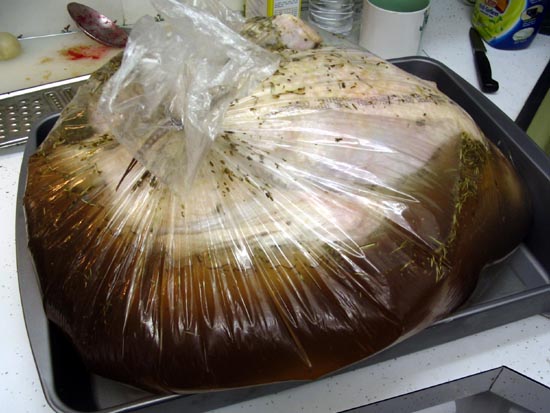
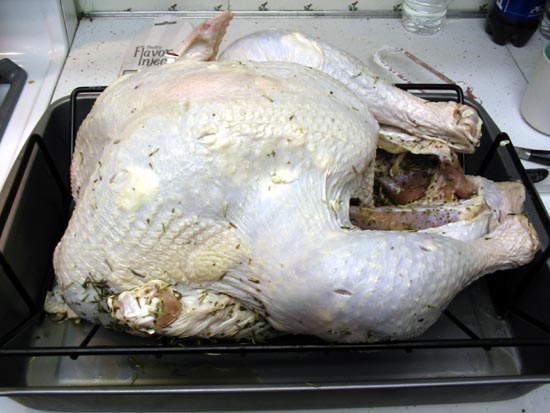
Step Two: Get the Massage
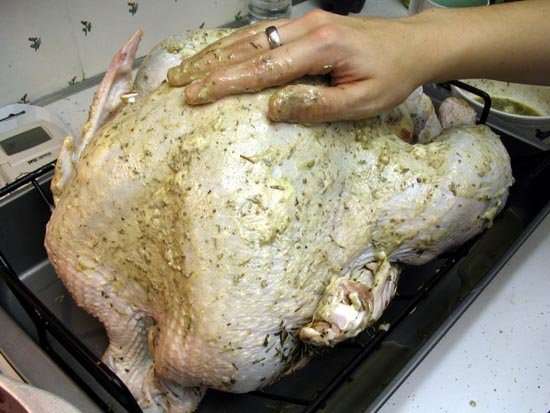
When it's time to cook, take the turkey out of the brine, rinse it off completely, pat it dry, and throw out the brine. Now it's time to butter up that bird. Whip some butter with the herbs of your choice -- rosemary, sage, and thyme will do nicely for a traditional flavor -- and insert lumps under the skin. Massage them in, then rub some butter around the outside of the bird as well. This will make for a photo-ready brown skin, and as the stuff gradually melts into the pan it becomes great gravy drippings.
Step Three: Stuff It
Some say that stuffing a turkey invites bacteria. Whatever. We do it, we're just very careful with it. Our recipe for stuffing is here, and the technique is thus: Take a cheesecloth and line the turkey cavity, leaving an inch or two to spare hanging out on all sides. Insert stuffing that has been completely cooled to the same temperature as the turkey, adding just one handful at a time until the space is filled. Twist together the edges of the cheesecloth and tie shut with butcher's twine or another non-flammable closure. When the bird is done, you'll just pull out the stuffing sack and take its temperature with a meat thermometer. If it's not 165 F, just bake in an oven-safe dish at 350 F until it is. Tasty, easy, and perfectly safe, we promise.
Step Four: Flipping the Bird
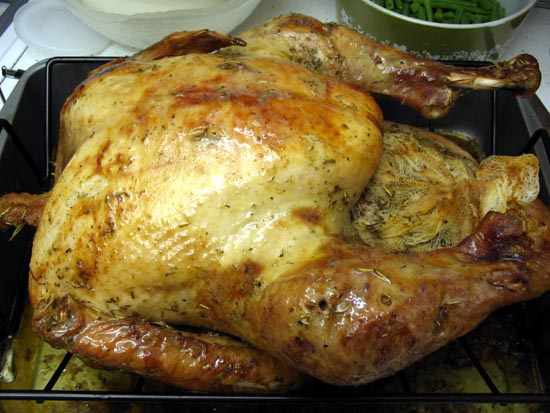
Now that you have a butter-massaged, stuffed turkey, you should tuck the wings under the shoulders (no need to actually truss unless they are really sticking out far) and position the bird breast-side up in a roasting pan. Roast it at 500 F for 30 minutes to brown the skin. After 30 minutes, flip it breast side down and drop the temperature to 350 F.* You'll keep it cooking until a thermometer inserted in the thickest part of the breast reads about 155 F. The temperature should go up to 160 F while resting. Don't overcook!
*If you don't have a rack, just a roasting pan, this brown-and-flip technique won't really work as the skin will be soaking in drippings when you flip. You might try simply covering the breast completely with foil for the remainder of the cooking time instead, though we can't vouch for it.
Step Five: Save the Baste for Last
While the turkey is cooking, you can occasionally swoop in and baste it with pan drippings. If the drippings aren't adequate early on, one can just take a stick of butter and rub it right on the bird.
Step Six: Timing Is Everything
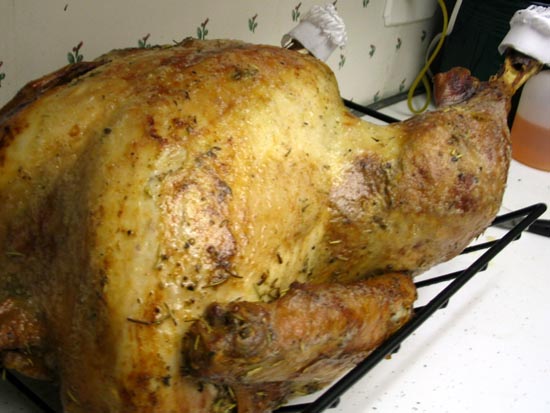
I can remember my mom getting up before dawn to get the turkey started when I was a child, but now I have to wonder what she was doing. Using our recipe, a 15-pound stuffed turkey should only take about 3.5 hours in the oven. The formula you can use is 12 to 15 minutes per pound (as per Joy of Cooking).
Epilogue: Carving and Gravy and Leftovers
When the turkey is done, let it rest for 20 minutes before carving. This gives you time to pop the stuffing back into the oven if necessary, and make gravy that takes advantage of a bonus you get with a farm-fresh turkey: genuine giblets.
If you have skin that hasn't quite crisped to your liking, don't be afraid to peel it off and pan-fry it up as you would bacon. It turns out so well you'll wish turkey skins were sold just like pork cracklings.
When all the meat has been craved away from the bone, don't just rip out the wishbone and call it a day. Boil them up for turkey stock and make yourself a big pot of soup.

Links
Back to Thanksgiving Dinner Main Page

Back to Bridge and Tunnel Club Home
Contact the Cleaver:
info -at- bridgeandtunnelclub.com



